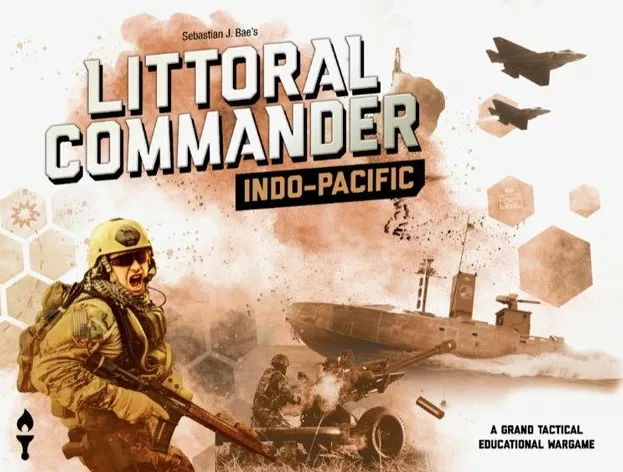The following designer diary is from Sebastian J. Bae, on his Littoral Commander: Indo-Pacific wargame. Bae designs games at the Center for Naval Analyses, teaches game design at Georgetown University, and left the US Marine Corps as a Sergeant.
Disclaimer: Littoral Commander is NOT a US government product and NOT owned or funded by the U.S. Marine Corps or any other government entity. This design is the intellectual property of its designer. This work represents the views of the designer alone and does not reflect or represent the opinions of the U.S. government, US Marine Corps, the CNA/Center for Naval Analyses, or any other affiliated organizations. All photos here are from the Littoral Commander: Indo-Pacific game page on BoardGameGeek.
I wrote this designer journal to offer a glimpse behind the design curtain. As a professional designer and hobby gamer, I always loved understanding how and why a design formed the way it did. What was the logic behind it? Why did a designer make specific compromises or abstractions in the game? No game is perfect — all games make compromises and abstractions. Often the difference between bad, good, and great is paradoxically slim, yet vast at the same time.
A bad game is host to unnecessary or inaccurate compromises and abstractions that detract from its core subject matter and purpose. A good game makes the necessary compromises and abstractions, which are tolerable and understandable. A great game makes players utterly forget about its abstractions and compromises—by building a world in which players are enthralled by the seamless harmonization of subject matter, storytelling, and game mechanics. Throughout this process, I always endeavored for Littoral Commander to be a great game.
But before I dive into the details of the design, I want to provide the origin story for Littoral Commander. Designing an educational wargame for Marines to explore the future of warfare has long been an ambition of mine. This is unsurprising, as I was a former infantry Marine myself and remain an avid lover and advocate of educational games. However, like many of us, I found that work and other priorities frequently pushed pet projects to the back burner.

Sebastian Bae
It wasn’t until the COVID-19 pandemic unfolded in the U.S. in 2020 that I finally found the time, energy, and drive to truly tackle this project. At the same time, the Marine Corps was embarking on a service-wide transformation, redefining how it would organize, train, and equip Marines to fight future conflicts. This initiative, later called Force Design 2030 (FD2030), sought to modernize the Marine Corps to face new battlefield realities. This included a wide range of issues, such as unmanned systems, contested logistics, and cyber threats.
A central FD2030 element was the Marine Littoral Regiment (MLR), a newly proposed formation that emphasized long-range fires, integrated air and missile defense (IAMD), and intelligence, surveillance and reconnaissance (ISR) capabilities. Moreover, the MLR and associated concepts such as Expeditionary Advanced Base Operations (EABO) and the Stand-In-Force (SIF) are only part of a wider transformation of the Marine Corps. Do not mistake the narrow scope of the game’s initial tactical scenarios or even the composition of the game’s MLR to be definitive.[1] This process is still ongoing and evolving, and if you are interested in learning more, I have included a list of references at the end. Many of the readings shaped my vision for this game.
Littoral Commander does not offer a comprehensive or definitive vision of what the MLR or FD2030 will look like in the future. Littoral Commander was designed to be an intellectual sandbox, enabling Marines to explore, test, learn, and expand on the core tenets of FD2030. It does not provide an answer, merely an intellectual venue to engage with difficult problems. Similarly, I wanted people to understand FD2030 and why the Marine Corps was pivoting in a new maritime direction.
Now, let’s talk about the fun stuff—game design! I will not cover every detail or specific abstraction in the game but focus on the main elements. First, let’s discuss simplicity and accessibility as core design tenets of Littoral Commander. Most professional military educational games are large, complex, and dependent on a facilitator.
I didn’t want this for Littoral Commander. I wanted a game where Marines could play against one another in the barracks. I wanted a game that officers could use to educate and train their units. I wanted normal people to understand and enjoy engaging with its ideas. I wanted thousands of eyes and minds staring at the wicked problems of the future, searching for a solution. Thus, as I designed the game, I mercilessly simplified, abstracted, and ripped out elements of the game that I thought were cumbersome or overly complicated. At times, I had a hard time letting go of a mechanic or idea that I was enamored with as a designer.
Luckily, Patrick McLaughlin, a Marine officer and member of my design team, routinely and loudly reminded me when the game was getting too complex. This is why the game has only four fundamental actions—engaging in combat, concealing units, playing a card, and resupplying units. So, if you see something missing, it is not a consequence of poor research or lack of ingenuity, but a commitment to the game’s central vision.
At its core, Littoral Commander is principally about the sensor-to-shooter chain, or the military process known as “find, fix, track, target, engage, and assess” (F2T2EA). In normal English, that means how a unit finds a target and executes an effect on it — whether that is a missile hitting a ship or communications being jammed. The core engine of the game is about this process of finding and engaging a target.
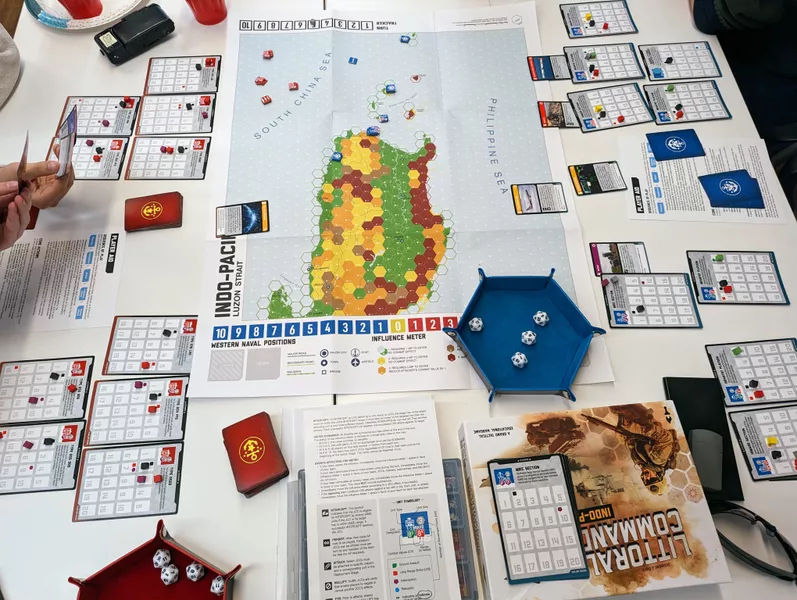
Littoral Commander: Indo-Pacific on the table. (Luzon map.)
Therefore, the imperfect knowledge aspect of “revealing units” and detecting certain Joint Capability Cards (JCCs) is critical. Players must wrestle with how they find targets and the risk associated with engaging them. If a player finds a target, they must ask themselves, “Is this target worth revealing my own units to attack it?” Likewise, players must consider how they avoid becoming targets themselves.
Information is a commodity in the game by design. A player may know where a unit is in one turn, but that knowledge quickly atrophies as the target moves and hides. Players must constantly find, fix, track, target, engage, and assess the opposing force.
Admittedly, the process is simplified in the game by excluding certain elements. For instance, the real-world requirement to do battlefield damage assessment (BDA) is wholly excluded as players know exactly the result of their attacks. This is not a reflection of reality, but a casualty of simplifying the process.
Likewise, the combat engine in tactical wargames is often a controversial and hotly debated issue. Even experienced designers can be tempted into trying to create a “hyper-realistic” combat model, falling prey to the seductive logic of more granular detail equating to more realistic combat results. Yet what often results is an unplayable grind. The art of wargame design is in finding the right balance between ease of play and necessary realism to achieve the game’s objectives and vision.
From its inception, Littoral Commander was designed to introduce the players to the key decision points future Marine commanders may face. This precluded the use of shot-by-shot combat adjudication based on the probability of hit/kill (often rolled up in a factor called single-shot probability of kill or SSPK). That meant I needed a way to combine a unit’s lethality into an easy-to-understand score.
I turned to Mike Bond, a fantastic military operations analyst and wargamer, to help develop the combat scoring system. Using his expertise in modeling and the work of Trevor Dupuy, a noted military operations researcher, Mike helped me create the underlying combat value scoring system for the game.
Within this system, each weapon system in a unit’s organic arsenal was scored on their expected number of kills per unit of time. Each weapon’s score was combined with the scores of other weapon types in the unit for an aggregated unit score, indicating the expected number of causalities that unit could inflict per unit of time. These raw scores were then binned based on an assumed Gaussian distribution to create the combat values players would use.
This system worked well for traditional combat units, such as tanks and infantry, but required modification for higher-end systems, such as air defense and long-range precision strike systems. Mike incorporated the salvo equations found in Wayne P. Hughes’ seminal work, Fleet Tactics, to score missile systems.
This created a more balanced combat system that is quick and easy to grasp, but also provides insights into future armed engagements. One can easily recognize Hughes’ salvo model in the game’s combat engine–where the attacker’s offensive power is subtracted by target’s defense power, which is applied to the staying power of the target. This is all to say that there is real math and research behind the numbers.
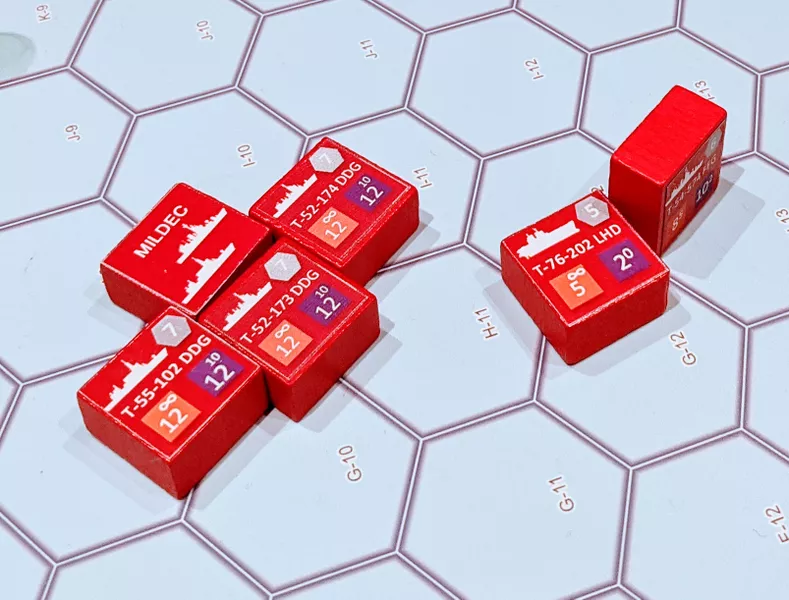
Prototype red blocks from Littoral Commander: Indo-Pacific.
However, there are limitations; two of which I would like to highlight. The implementation of IAMD is immensely complicated – involving radar detection, response time, geometry of fires, and a slew of other factors.
Littoral Commander simplifies this process by focusing on the concept of an IAMD umbrella where an IAMD system can provide protection and fixes the point of reference to the target and the IAMD system. This unfortunately eliminates the use of flight path interception, where a missile salvo can be intercepted at any point in its attack path even if the final target is beyond the defender’s range.
Similarly, the varying aspects of munitions and their effectiveness on specific types of targets is largely abstracted away–beyond the initial calculus in their combat values. This allows players to employ ship-killing missiles against ground targets and vice versa. Although early designs experimented with munition distinctions against target types, the added complexity provided limited utility for the complexity required.
Yet when required, I have created house rules or adaptions to the core rules to accommodate a specific focus or learning requirement. My hope is to refine these house rules further for subsequent editions as a menu of add-on mechanics to the core rule set.
All models have fundamental assumptions, and ours is no different. The most glaring issue is that a unit’s combat lethality in Littoral Commander is only determined by its hardware. The game excludes important factors like morale, proficiency, and fatigue.
In the real world, units are not carbon copies of each other. Some units will have better leaders; some units will be more proficient or possess better morale than others. Many wargames feature these factors as central elements, as they should.
However, in designing Littoral Commander, these factors were left on the cutting room floor for the sake of simplicity, speed of play, and teaching players about current and future capabilities. If you feel like adding these elements, I encourage players to explore house rules and bend the game system to their will.
In creating the maps for Littoral Commander, McKenzie Kramer, our talented geographer, had to incorporate a diversity of geographical spaces, including cities, dense jungles, and shallow littorals.[2] To create a rigorous yet simple framework, the game system utilizes terrain factors, an index ranging from one to five which abstracts the constraints imposed by geography on movement, combat, and sustainment. This approach incorporated the Indo-Pacific’s topography, land cover, infrastructure, and oceans through open-source, real-world geographic data processed in Esri ArcGIS.
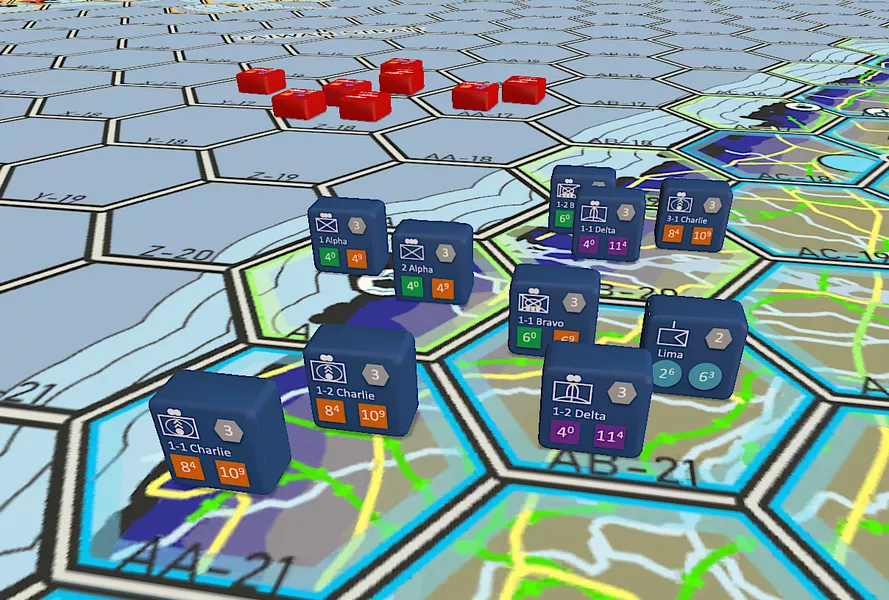
Blocks in a Tabletop Simulator Littoral Commander: Indo-Pacific module.
First, a 30-meter resolution digital elevation model (DEM) from the NASA Shuttle Radar Topography Mission (SRTM) was clipped to the area of interest and converted from raw elevation (in meters) to percent slope. The mean slope value for each hex was recorded, then transformed into an index value which rated the severity of the topography within the hex.
Areas of high mean slope suggested steep terrain with large amounts of undulation (hills, mountains etc.). The maximum slope value became a modifier which could increase the overall slope score for the hex. The maximum slope modifier was intended to account for features like canyons or escarpments that may otherwise have been averaged out if surrounded by flat plains or gentle hills.
Next, a 300-meter resolution landcover raster depicting majority landcover was used to derive the dominant landcover type found in each hex (cropland, scrub, artificial etc.). Landcover types which greatly inhibit the movement of mechanized ground forces (marshes, forests etc.) were given a modifier that was added to the overall hex terrain score.
Vector data was then added to represent lines of communication (roads, railways etc.). This data was categorized based on quality and size. Large highways—which facilitate quick overland travel—were given large modifiers, while minor roadways were given a smaller modifier. As these features improved mobility, their modifier was negative and reduced the overall terrain score within the hex.
For naval areas, a bathymetry raster was used to derive the mean and minimum depth of hexes with a mean slope of zero (surface water or open ocean). Ocean areas with a low mean depth or a minimum depth less than the draft of a common warship were given modifiers that increased their overall terrain factor. This represents the extra caution required to safely navigate shallow areas.
Finally, the scores from each category, along with any modifiers, were totaled and weighted to produce a final terrain factor value between one and five. Though highly generalized, each hex was classified using a repeatable, quantitative, and data informed approach. The result was a game map which faithfully represents the challenging landscape of the Indo-Pacific and its myriad possibilities for creative maneuver, tactics learning, and fun.
The next critical element of Littoral Commander is the card-driven effects of the JCCs. There is a lot to unpack here. First, the card-driven mechanic of playing special effect cards was an easy way to feature a wide spectrum of joint capabilities.
Modern warfare is truly all-domain, which means threats and challenges exist and converge across the domains of air, land, sea, cyber, and space. The JCCs allow for this complexity and richness in interplay to exist without a litany of specific rules. A player simply reads the card and executes its effect.
Admittedly, some JCCs and their effects caused me more heartache than others. For instance, the submarine and anti-submarine warfare (ASW) mechanics of the game continually caused me frequent grief. So, to all the submariners, I apologize for the oversimplification. Forgive me, but this game isn’t about you. If you want a great submarine wargame, there are wargames that do it better.
Likewise, logisticians may take offense from being given no combat ability. This isn’t an assessment of your combat prowess, but a reflection of the limitations of space on a counter. Not to mention, if your logisticians are engaging in firefights, you have other, bigger issues.
Lastly, some JCCs and their effects were constrained by the scarcity of publicly available information. This is most true for the projected future systems—which resulted in accepting the effectiveness of these platforms at face value.
Given the secrecy of cyber capabilities, most cyber JCCs boast a roughly 55 percent effectiveness rate paired with potent effects. This struck a balance between highlighting the power of cyber techniques and avoiding mischaracterizing them as a panacea.
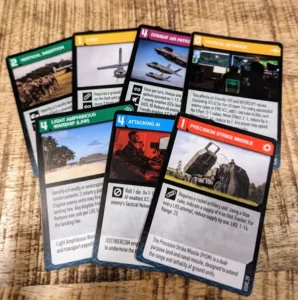
A look at some cards for Littoral Commander: Indo-Pacific.
The card mechanic is also important to highlight the joint aspect of warfare. Although Marines are heavily featured as the units on the map, players quickly learn that joint capabilities are essential for success. Marines do not fight or win campaigns alone. Likewise, players succeed when they can weave all the elements together — whether that is leveraging Army logistics watercraft or employing Air Force bombers.
However, this leads to another challenge in the design. Modern capabilities are complex and provide multiple effects and missions. For instance, one of the most complex JCCs in the game is “Combat Air Patrols,” which has a litany of effects. Similarly, other capabilities were simplified or feature only the predominant mission of a particular platform in its effects.
An example of a simplification is the assumption that any observing ISR platform, particularly unmanned platforms, are always within weapon’s range. Yet, this is not always the case given the variety of ways to conduct ISR. This fundamental assumption was required for a smooth, simple card mechanic. Overall, I attempted to balance accessibility and ease of play with due diligence in representing real world capabilities at the tactical level.
Ironically, first-time players will frequently complain about the number of cards in the game, describing it as overwhelming. Yet after they get another game under their belt, players will undoubtedly rattle off card ideas that should have been included in the game.
Admittedly, the JCCs do not represent the entirety of the Joint Force nor all the effects of any specific capability. The game takes a “dim sum approach,” where players get a little taste of everything.
But this highlights an opportunity presented by the card-based approach: customizability. If the game doesn’t have your pet rock capability, then add it. Make your own card. And if it follows the grammar of the game system, it works.
Likewise, a player does not need to know every card’s effect to play the game. And over time, players’ literacy of the cards and their associated capabilities will increase as they discover new cards and effects they never played before. This facet of the game design is my favorite.
On a related note, the scenario-based approach enables players to create their own explorations in the sandbox. The scenarios in the base game serve only as beginning points. I want players to create their own scenarios, to think of interesting dynamics and narratives.
The customizability of Littoral Commander allows the game to have legs and adapt to its environment. The game will be used differently at a rocket artillery battery, an engineer support battalion, and a hobbyist game table.
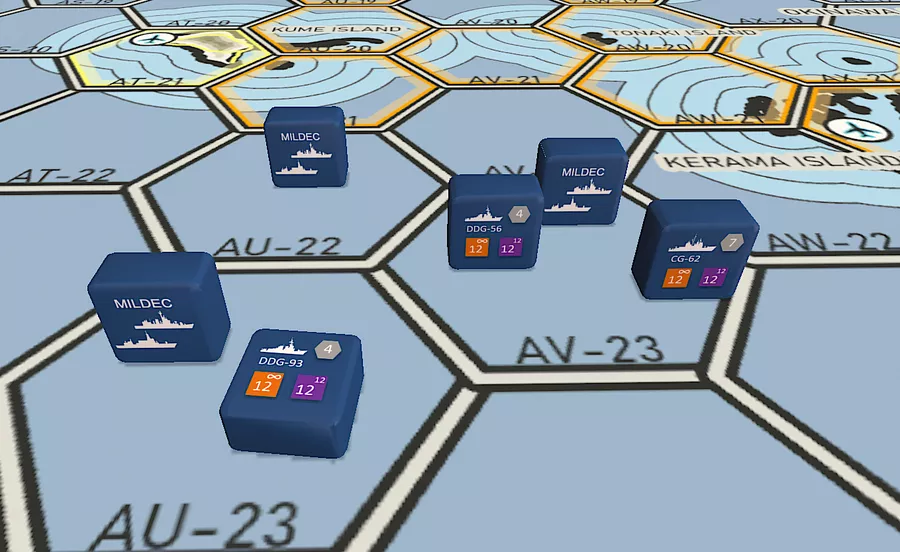
U.S. Navy ships in a Tabletop Simulator module for Littoral Commander: Indo-Pacific.
Now, let’s shift gears a bit and discuss the influence mechanic. I will be the first to admit that the influence mechanic is imperfect. Influence does not work on the same timescale as missiles flying, nor is it as quantifiable as combat scores. Nevertheless, I included it in the game because I wanted players to consider, even in the slightest, the effects of influence and perception.
I even thought about creating an influence stage in the core rule set to represent the tug-o-war for access and basing in the region. This feature was ultimately cut from the core rule set for simplicity and scope, but I retained elements of the influence meter.
This is best highlighted by the importance of influence in some of the scenario objectives. This was my crude way of representing that perception and people matter — that these hexes are not empty spaces, but populated areas. Furthermore, I wanted to highlight that there are more tools in the toolkit than missiles and bullets.
Compared to other wargaming titles, the commercialization process for Littoral Commander was unique in many respects. The game was originally targeted towards Marines and the wider Joint Force for educational use within their tactical units. This meant that certain elements had to be adjusted or stripped for the wider public, while other elements were added.
For instance, the Unit Trackers in the game were originally printed Excel sheets to track munitions. This was expedient for units who wanted to customize scenarios for their needs but was untenable for a commercial release. As a result, the Unit Trackers were created to maintain customization, while also allowing flavor text to be added to help those unfamiliar with NATO symbology.
At the same time, color blindness was a key factor in shaping the game’s aesthetic. This included the shapes and colors used for unit combat values, the design of the JCCs, and the color palette and associated values for terrain factors on the map. I wanted the game’s aesthetic to be impressive, but also deeply functional. In this regard, Jacob Walker, the illustrator for the game, was indispensable.
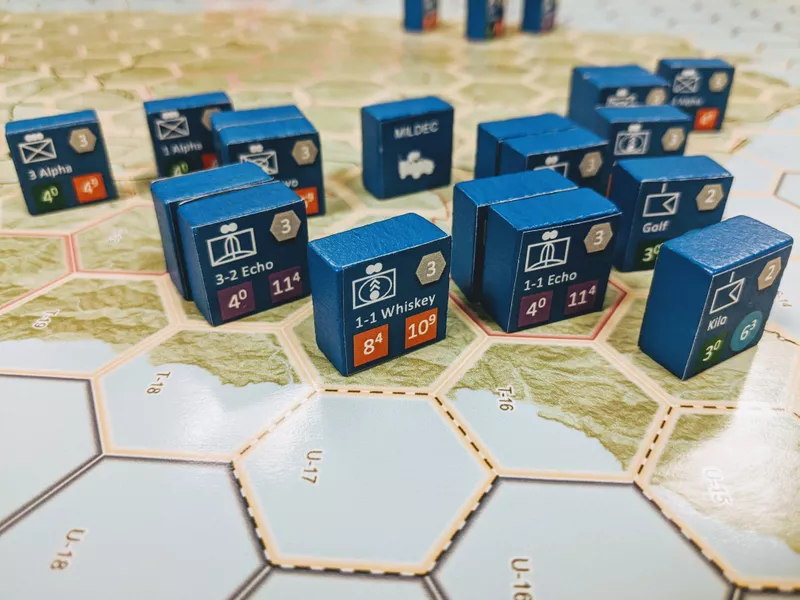
Prototype blue wood blocks for Littoral Commander: Indo-Pacific.
Looking forward, I have tremendous hopes for the success of Littoral Commander and aspirations of extending the game with a series of expansions. Currently, I am working on a follow-up expansion exploring future operations in northern Europe. The working vision is to include the Army’s Multi-Domain Task Force (MDTF) and a future variant of the Marine Corps’ Amphibious Ready Group and Marine Expeditionary Unit (ARG MEU).
Although the details remain tentative and fluid, the design aims to expand the game’s aperture into the future with the inclusion of different scenarios, formations, and dilemmas. And some time after that, I hope to further expand the Littoral Commander universe by adding units from other allies and partners, ranging from the Japanese Self-Defense Force (JSDF) to the British Royal Marines.
I want to end this discussion of wargames and designs with a focus on people. At its core, professional wargaming is about improving the decision-making of the players. Educational wargames, like Littoral Commander, do not provide definitive answers. Wargames simply provide the venue and means to search for the answers through experiential learning—by engaging with another active mind that reacts and adapts. We should all endeavor to learn more through play.
Postscript
Littoral Commander is the culminating product of dozens of amazing individuals who helped me shape and design the game. These include but are not limited to my design team, who helped with the research and rules refinement; the scores of experts who offered their insights; the uniformed service members who playtested it and advocated for its use; and a patient and supportive illustrator (Jacob Walker), editor (Jon Healey), and publisher (Jim Dietz). This game would not be what it is today without their immense support — so I want to thank them for believing in me and Littoral Commander.
The Designer: Sebastian J. Bae, a research analyst and game designer in the defense industry, works in wargaming, emerging technologies, and the future of warfare. He also serves as an adjunct assistant professor at the Center for Security Studies at Georgetown University, where he teaches a graduate course on designing educational wargames. He previously taught similar courses at the U.S. Naval Academy and the U.S. Marine Corps Command & Staff College. He is also the faculty advisor to the Georgetown University Wargaming Society, the Co-Chair of the Military Operations Research Society Wargaming Community of Practice, and a Fellow at the Brute Krulak Center for Innovation and Creativity. Previously, he served six years in the Marine Corps infantry, leaving as a sergeant. He deployed to Iraq in 2009.
References:
Alford, Julian. “Implementation of the Hunter Killer Platoon.” The Marine Corps Gazette 106, no. 02, February 2022. ‘
Armstrong, Benjamin and John Freymann, Developing the Naval Mind, Naval Institute Press, 2021.
Berger, David. “Commandant’s Planning Guidance – 38th Commandant of the Marine Corps.” United States Marine Corps Flagship, July 15, 2019.
Berger, David. “The Case for Change.” The Marine Corps Gazette 104, no. 06, June 2022.
Cichon, Fredrick “Andy”. “Eabo Must Be a Joint Effort.” Proceedings. U.S. Navy, March 31, 2022. https://www.usni.org/magazines/proceedings/2022/april/eabo-must-be-joint-effort.
Cuomo, Scott, Noah Spataro, Olivia A Garard, and Jeff Cummings. “Getting the Context of Marine Corps Reform Right.” War on the Rocks, May 13, 2020. https://warontherocks.com/2020/05/getting-the-context-of-marine-corps-reform-right/.
Cuomo, Scott. “On-the-Ground Truth and Force Design 2030 Reconciliation: A Way Forward.” War on the Rocks, July 12, 2022. https://warontherocks.com/2022/07/on-the-ground-truth-and-force-design-2030-reconciliation-a-way-forward/.
Emmanuel, Gordon. “Smash Bullies.” The Marine Corps Gazette 104, no. 06, June 2022.
Flynn, Karl. “Unmanned Vessels for EABO.” Proceedings, October 31, 2021. https://www.usni.org/magazines/proceedings/2021/november/unmanned-vessels-eabo.
Hammes, T. X. “Building a Marine Corps for Every Contingency, Clime, and Place.” War on the Rocks, April 14, 2020. https://warontherocks.com/2020/04/building-a-marine-corps-for-every-contingency-clime-and-place/.
Headquarters Army, “ATP 7-100.3 – Chinese Tactics,” Army Publishing Directorate, August 2021, https://armypubs.army.mil/epubs/DR_pubs/DR_a/ARN33195-ATP_7-100.3-000-WEB-1.pdf.
Headquarters Marine Corps. “Expeditionary Advanced Base Operations (EABO).” United States Marine Corps, August 2, 2021. https://www.marines.mil/News/News-Display/Article/2708120/expeditionary-advanced-base-operations-eabo/.
Headquarters Marine Corps. “Force Design 2030 Annual Update.” United States Marine Corps, May 2022. https://www.marines.mil/Portals/1/Docs/Force_Design_2030_Annual_Update_May_2022.pdf?ver=7ul-eyF6RcSq_gHU2aKYNQ%3D%3D
Headquarters Marine Corps. “Talent Management 2030 Annual Update.” United States Marine Corps, November 2021. https://www.hqmc.marines.mil/Portals/142/Users/183/35/4535/Talent%20Management%202030_November%202021.pdf
Headquarters Marine Corps. “Concept for Stand-in Forces.” United States Marine Corps, December 2021. https://www.hqmc.marines.mil/Portals/142/Users/183/35/4535/211201_A%20Concept%20for%20Stand-In%20Forces.pdf?ver=MFOzu2hs_IWHZlsOAkfZsQ%3D%3D
Howard, Mark. “Expeditionary Advanced Base Operations and Mine Warfare in Littoral Control.” Center for International Maritime Security, June 9, 2020. http://cimsec.org/expeditionary-advanced-base-operations-and-mine-warfare-in-littoral-control/44201.
Hughes, Wayne and Robert Girrier, Fleet Tactics and Naval Operations: Third Edition, Naval Institute Press, 2018.
Jensen, Benjamin. “The Rest of the Story: Evaluating the U.S. Marine Corps Force Design 2030.” War on the Rocks, April 27, 2020. https://warontherocks.com/2020/04/the-rest-of-the-story-evaluating-the-u-s-marine-corps-force-design-2030/.
Leslie, Edward, Jesse Hume, Jonathan Inglett, and Michael Hogan. “FD2030 Infantry Battalion Experimentation.” The Marine Corps Gazette 105, no. 02, February 2021.
Littoral Operations in a Contested Environment, Department of the Navy, 2017.
Mills, Walker. “SEA CONTROL 322 – MARINE CORPS INFANTRY’S ROLE IN EABO.” Center for International Maritime Security, March 2, 2022. https://cimsec.org/sea-control-322-marine-corps-infantrys-role-in-eabo/.
Mills, Walker. “Small Boats: Marines and the Future of Littoral Warfare,” Marine Corps Gazette, December 2019, p. 23-26.
Nguyen, Phuchung, “It’s On: Squadron Challenges Personnel To War Game,” Marine Corps Air Station Iwakuni, Japan, U.S. Marine Corps, May 6, 2022, https://www.marines.mil/News/News-Display/Article/3023016/its-on-squadron-challenges-personnel-to-war-game/.
Riccio, Marc, and William Grimball. “Command and Control Considerations for EABO.” The Marine Corps Gazette 104, no. 04, April 2022.
Simcock, Richard L. “HIMARS: Forward Deployed in the Pacific,” Marine Corps Gazette, August 2016, p. 24-26.
South, Todd, “This Marine vet created a wargame for enlisted leaders,” Marine Corps Times, March 17, 2023, https://www.marinecorpstimes.com/news/your-marine-corps/2023/03/17/this-marine-vet-created-a-wargame-for-enlisted-leaders/.
“Tentative Manual for Expeditionary Advanced Base Operations .” Marine Corps Warfighting Laboratory, 2019. https://www.mcwl.marines.mil/TMEABO/.
Timothy A. Walton, Ryan Boone, and Harrison Schramm, Sustaining the Fight: Resilient Maritime Logistics for a New Era, CSBA, 2019.
“Wargaming as Training with Major Zachardy Schwarts and SSgt David Wood,” Tactics and Operations, MCTOG, Feb 28, 2023, https://open.spotify.com/episode/33sihn6a5s5HScUN4yFMZb?si=a235058eccb24954
[1] The wargame uses small units, such as platoons and sections, to allow players to disaggregate their units across the battlefield. The absence of a stacking limit (how many units can be in a hex) allows players to aggregate into larger formations for ground combat actions.
[2] The scale of 20km hexes may seem jarring at first for a tactical wargame, but the focus on maritime campaigning and the significant ranges of modern weapon systems necessitated this scale.
